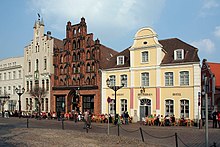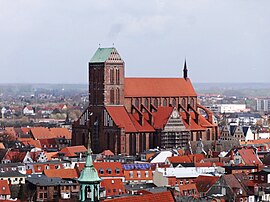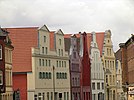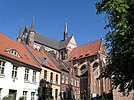Wismar
Wismar | |
|---|---|
Clockwise from top:St Nicholas' Church,St George's Church, Market Square with waterworks, Old Harbour, Gewölbe, colorful houses in the old town | |
| Coordinates:53°54′N11°28′E/ 53.900°N 11.467°E | |
| Country | Germany |
| State | Mecklenburg-Vorpommern |
| District | Nordwestmecklenburg |
| Government | |
| •Mayor(2018–25) | Thomas Beyer[1](SPD) |
| Area | |
| • Total | 41.36 km2(15.97 sq mi) |
| Elevation | 15 m (49 ft) |
| Population (2022-12-31)[2] | |
| • Total | 43,878 |
| • Density | 1,100/km2(2,700/sq mi) |
| Time zone | UTC+01:00(CET) |
| • Summer (DST) | UTC+02:00(CEST) |
| Postal codes | 23952, 23966, 23968, 23970 |
| Dialling codes | 03841 |
| Vehicle registration | HWI |
| Website | www |
Wismar(German pronunciation:[ˈvɪsmaʁ];Low German:Wismer), officially theHanseatic City of Wismar(Hansestadt Wismar) is, with around 43,000 inhabitants, the sixth-largest city of the northeastern German state ofMecklenburg-Vorpommern,and the fourth-largest city ofMecklenburgafterRostock,SchwerinandNeubrandenburg.The city was the third-largest port city in formerEast Germanyafter Rostock andStralsund.
Wismar is located on theBay of Wismarof theBaltic Sea,directly opposite the island ofPoel,that separates the Bay of Wismar from the largerBay of Mecklenburg.The city lies in the middle between the two larger port cities ofLübeckin the west, andRostockin the east, and the state capital ofSchwerinis located south of the city onLake Schwerin.Wismar lies in the northeastern corner of theHamburg Metropolitan Region,and is the capital of the district ofNorthwestern Mecklenburg.The city's natural harbour is protected by apromontory.The uninhabited island ofWalfisch,lying between Wismar and the island ofPoel,administratively belongs to the borough of Wismar-Wendorf.
It is estimated that Wismar was founded in 1226 underHenry Borwin I, Lord of Mecklenburgfrom theHouse of Mecklenburg,a German dynasty of Slavic origin also known as theObotritesor Niklotides. In 1259, the city became part of theHanseatic League.Throughout its history, the city has been under control of various German states as well as theSwedish Empire.It was part of Sweden from 1648 until 1803 (de jure until 1903, when Sweden officially renounced its claims to the city), and this Swedish chapter of the city is celebrated annually with a large "Sweden Celebration". From 1815 until 1918, Wismar lay in theGrand Duchy of Mecklenburg-Schwerinand later in theFree State of Mecklenburg-Schwerin.
Wismar is a typical representative of theHanseatic Leaguewith its city-wideBrick Gothicstructures and iconic gabled patrician houses and was inscribed on theUNESCOWorld Heritage Listalongside the historical old town ofStralsundin 2002.[3]Wismar is the seat ofHochschule Wismar,a university of applied sciences, one of nine institutions of higher education in Mecklenburg-Vorpommern. WithMV Werften Wismar,the city is one of three cruise ship-producing locations ofMV Werften(along with Rostock andStralsund), and the shipyard with its tall white-blue hall is one of the city's largest employers. St. George's,St. Nicholas'and St. Mary's, of which only the tower is left standing, are the three iconic sacred buildings dominating the skyline of Wismar.
History
[edit]
The name of the settlement was first recorded in the 12th century as Visemer, Wismar (1147, 1167), Wyssemaria (1229)[1][4]and is probably of Slavic origin although finally disputed. Wismar could have the sameos.origin like the german city Weimar[5]Wismar was part of the Western SlavicObotrites' territory.
The exact date of the city's foundation is not clear. In the oldest existing document of Wismar of 1229 its civic rights are already established. In 1301 Wismar came under the rule of theHouse of Mecklenburg.[6]In 1259 Wismar joined a defensive agreement with Lübeck andRostock,in order to effectively counter the numerous Baltic pirates. Subsequently more cities of the northernHoly Roman Empirewould agree to cooperate as commerce and trade was increasingly coordinated and regulated. These policies would provide the basis for the development of theHanseatic League.By the 13th and 14th centuries Wismar had grown into a flourishing Hanseatic trading hub and an important center of wool processing. Although around 2,000 of its inhabitants perished during the plague of 1376, the town remained reasonably prosperous until the 16th century.[7][8]
Under Swedish rule
[edit]
| UNESCO World Heritage Site | |
|---|---|
 Alter Schwede,c. 1380 | |
| Part of | Historic Centres ofStralsundand Wismar |
| Criteria | Cultural: ii, iv |
| Reference | 1067-002 |
| Inscription | 2002 (26thSession) |
| Area | 88 ha |
| Buffer zone | 108 ha |
With thePeace of Westphaliaof 1648 Wismar came under the territorial control ofSweden.Through the acquisition of Wismar and otherdominionsin theHoly Roman Empire,theKings of Swedenin their role asimperial princeswere entitled to a seat in theImperial Diet.Wismar became administrative center of Wismar town and the districts of Pod andNeukloster,and after 1653 theFürstenhof(prince's court) served as the seat of the supreme court for all Swedish dominions in the Holy Roman Empire. Wismar's fortifications were extended into an effective all-round defence system under the supervision of Field MarshalErik Dahlbergh.Remains of these fortifications have been preserved, among other places, in the ‘Lindengarten' to the east of the wall of the old city.[9][10]During theScanian War,the town was besieged and captured byDanishforces in 1675.
In 1803, Sweden ceded both the town and lordship to theGrand Duchy of Mecklenburg-Schwerinfor 1,258,000Riksdalers,but reserved the right of redemption after 100 years. In view of this contingent right of Sweden, Wismar was not represented at thedietofMecklenburg-Schwerinuntil 1897. In 1903, Sweden finally renounced its claims to the town. Wismar still retains a few relics of its old privileges, including the right to fly its own flag.[7][11][12]
20th century
[edit]By the end of the 19th century Wismar's most important manufacturing branches were the production of iron and steel, roofing-felt, asphalt, paper and machine industry. International sea trade took place at the local harbour, which was deep enough to admit vessels of up to five metres (16 ft) draught at its quays. Exports included grains, oil-seeds and butter as coal, timber and iron were imported.[7]Wismar was production site for several railroad rolling stock manufacturers and since 1933 home toNorddeutsche Dornier-Werkeof aircraft manufacturerDornier.[13]On 14 May 1881Rudolph Karstadtopened his first shop (Tuch-, Manufaktur- und Konfektionsgeschäft) of the now well established department store chainKarstadtin Wismar.[14]
DuringWorld War II,it was the location of aforced laboursubcamp of the Nazi prison inBützow-Dreibergen.[15]Wismar was heavily bombed and destroyed byAllied air raids.As theline of contactbetween Soviet and other Allied armies formed in Europe at the end of the war, Wismar was captured by the British6th Airborne Division's1st Canadian Parachute Battalionon 2 May 1945,[16]James Hillcommanding, in accordance with Operation Eclipse. On 7 May 1945 British Field MarshalMontgomeryand Soviet MarshalKonstantin Rokossovskymet in Wismar. In accord with theOccupation Zone Agreementsof theYalta ConferenceWismar became a part of theSoviet Occupation Zoneof Germany on 1 July 1945, as British troops retreated and Soviet troops took control over the area.
During the 1949 to 1990 era of theGerman Democratic Republic,Wismar became East Germany's second-largest port, afterRostockand developed a shipbuilding industry. Although the GDR government had pledged to restore the local churches and historic sites that had been heavily bombed during the war, this commitment was for the most part not fulfilled.
After German reunification in 1990, churches and all historic buildings in the city's town center were restored, and the old towns of Wismar andStralsund(c.110 km or 70 mi to the east), were listed as UNESCOWorld Heritage Sites.In 2011, Wismar became the capital of thedistrictofNordwestmecklenburg.[17]

Mayors and Lord Mayors
[edit]- 1919–1929: Lawyer Hans Rasp (1877–1957, SPD)
- 1929–1933: Heinrich Brechling (1897–1959, SPD)
- 1933–1945: Alfred Pleuger (NSDAP)
- May 1945 – June 1945: Heinrich von Biel (independent)
- June 1945 – August 1945: Heinz Adolf Janert (1897–1973) (independent)
- August 1945 – 1945: Karl Keuscher (KPD)
- September 1945 – 1945: August Wilke (KPD)
- December 1945 – December 1950: Herbert Säverin (1906–1987) (SPD/SED)
- January 1951 – June 1952 Erhard Holweger (1911–1976) (SED)
- August 1953 – June 1957: Herbert Kolm (SED)
- July 1957 – April 1969: Herbert Fiegert (SED)
- April 1969 – November 1989: Günter Lunow (born 1926) (SED)
- November 1989 – May 1990: Wolfram Flemming (SED), temporary
- 1990–2010: Rosemarie Wilcken (born 1947) (SPD)
- Since July 2010: Thomas Beyer (born 1960) (SPD)
Sights and architecture
[edit]
The historical old town, centered on the huge marketplace (one of the largest in northern Germany at 10,000 m2or 110,000 sq ft), is characterized by town houses, manufacture and trading structures of the Hanseatic League, built inBrick Gothicstyle during the 13th to 15th centuries, 19th-centuryRomanesque Revival architectureandArt Nouveauhouses. Distinctive buildings and military works, built during the period of Swedish control during the 17th and the 18th centuries provide another layer of cultural influence.[3]
The market square's focal point is theWasserkunst,an elaborate wrought-iron fountain imported from Holland in 1602. The northern side of the square is occupied by the Town Hall, built inNeoclassicalstyle from 1817 to 1819. Another notable building on the square is aBrick Gothicpatrician's home (Bürgerhaus) calledAlter Schwede(Old Swede), erected around 1380.
St. George's Church, the third so-named edifice on the site, dates from 1404. It had escaped major damage during most of World War II, but on 14 April 1945, three weeks before the end of the war it was badly damaged by "Blockbuster bombs"dropped by the British Royal Air Force. Reconstruction after German reunification, costing some 40 million Euros, was completed in 2010.
The 80-metre-high (260 ft) tower church of St. Mary's Church (Marienkirche) is the only remainder of the originalBrick Gothicedifice, built during the first half of the 13th century. It suffered heavy damage in World War II, and was partially razed in 1960 during theEast Germanera.
St. Mary's Church and the church ofSt. Nicholas(Nikolaikirche) with its very lofty vaulting, built from 1381 to 1460, serve as prime examples ofLübeck'sSt. Mary's Churchesarchitectural influence on the entire region.[7]
TheFürstenhof,a richly decorated specimen of early ItalianRenaissancestyle was once aducalresidence and served later as the seat of themunicipalauthorities. Built from 1552 to 1565, it was restored from 1877 to 1879. TheOld School,dating from about 1300, has not been restored yet. The town hall, rebuilt in 1829, houses a gallery of paintings.[7]The Fine Arts Municipal GalleryBaumhausis located in the old harbour area.
Education
[edit]Economy
[edit]Nordic Yards Wismaris a shipbuilder located in Wismar and shipbuilding has existed since 1946 at the site.




Notable people
[edit]- Klaus Störtebeker(c. 1360–1401), privateer
- Sophie of Mecklenburg-Güstrow(1557–1631), queen ofDenmarkandNorway
- Daniel Georg Morhof(1639–1691), writer, scholar and historian.[19]
- Johan Henrik Scheffel(1690–1781), Swedish painter
- Johan Carl Wilcke(1732–1796), physicist
- Henricus Christophorus Christianus Wegener(1757–1799), lawyer
- Friedrich Christoph Dahlmann(1785–1860), historian, statesman.[20]
- Heinrich Keil(1822 in Gressow – 1894), philologist
- Theodor Martens(1822–1884), architectural and landscape painter
- Friedrich Bernhard Christian Maassen(1823–1900), law professor.[21]
- Gottlob Frege(1848–1925), mathematician, logician and philosopher
- Hermann Ritter(1849–1926), viola player, composer and music historian.
- Guglielmo Plüschow(1852–1930), a German photographer of male nudes in Italy
- Marie Musaeus Higgins(1855–1926), founder ofMusaeus College,Colombo
- Franz Ziehl(1857–1926), bacteriologist
- Elisabeth Krämer-Bannow(1874–1945), ethnologist, explored theislands of the South Pacific.
- Gustav Neckel(1878–1940), Germanist and Scandinavist
- Anton von Hohberg und Buchwald(1885–1934), Reichswehr and SS officer
- Helmuth Wohlthat(1893–1982), civil servant and diplomat
- Harald Weinrich(born 1927), classical scholar; scholar of Romance philology and philosopher
- Uwe Holmer(1929-2023), pastor, author and theologian; housedErich Honeckerand hiswife
- Gunter Pleuger(born 1941), diplomat and politician
- Klaus Grünberg(born 1941), actor
- Simone Oldenburg(born 1969), politician, local Deputy Minister-President since 2021.
- Thomas Wiegand(born 1970), electrical engineer; substantially contributed tovideo coding formats.
Sport
[edit]- Heino Kleiminger(1939–2015), footballer
- Peter Sykora(born 1946), footballer, played over 270 pro games
- Joachim Streich(1951-2022), football player and coach, played 378 games and 98 forEast Germany
- Marita Koch(born 1957), track and field athlete of the GDR and1980 Summer Olympicschampion
- Roswitha Eberl(born 1958), canoeist
- Kerstin Brandt(born 1961), high jumper
- Andreas Zachhuber(born 1962), football player and coach
- Kathrin Haacker(born 1967),1988 Summer Olympicschampion in rowing
- Fiete Sykora(born 1982), footballer, played over 430 pro games
- Robert Tesche(born 1987), footballer, played over 400 pro games
Wismar in art and literature
[edit]- Wismar (renamed "Wisborg" ) was the setting of the 1922 silent filmNosferatu, eine Symphonie des Grauens(Nosferatu: A Symphony of Horror). ThisGerman Expressionisthorror film,directed byF. W. Murnauand starringMax Schreckas thevampireCount Orlok,was partly shot in Wismar. Filming began in July 1921, with exteriorshotsin Wismar. Atakefrom the Marienkirche's (Saint Mary's Church) tower over Wismar marketplace with the Wasserkunst Wismar (waterworks fountain) served as theestablishing shotfor the Wisborg scene. Other locations included theWassertor(Water Gate), the southside ofSt. Nicholas,theHeilig-Geist-Kirche(Holy-Spirit-Church) and the harbour area.
- Wismar was also the setting ofWerner Herzog's 1979 remakeNosferatu, Phantom der Nacht.However, Herzog unable to film in Wismar, relocated his production to the cities of Delft and Schiedam in the Netherlands. The 2000metafictionhorror filmShadow of the Vampire,directed by E. Elias Merhige which depicts the filming of the 1922 silent movie also takes place in Wismar.
Twin towns – sister cities
[edit]In addition, since 1991 there is a friendship withHaldenin Norway.[23]
See also
[edit]- State Museum of Technologyoutside of Wismar.
References
[edit]This articleneeds additional citations forverification.(August 2020) |
- ^Kommunalwahlen in Mecklenburg-Vorpommern, Ergebnisse der Bürgermeisterwahlen,Mecklenburg-Vorpommern, Landesamt für innere Verwaltung, accessed 2 August 2021.
- ^"Bevölkerungsstand der Kreise, Ämter und Gemeinden 2022"(XLS)(in German).Statistisches Amt Mecklenburg-Vorpommern.2023.
- ^ab<"Historic Centres of Stralsund and Wismar".UNESCO World Heritage Centre.United Nations Educational, Scientific, and Cultural Organization.Retrieved27 August2022.
- ^Mecklenburgisches Urkundenbuch.
- ^Niemeyer, Manfred (2012).Deutsches Ortsnamensbuch.Berlin: De Gruyter.
- ^Friedrich Crull (1875).Die Rathslinie der Stadt Wismar- p. XVII ff.Buchhandlung des Waisenhauses.
- ^abcdeOne or more of the preceding sentences incorporates text from a publication now in thepublic domain:Chisholm, Hugh,ed. (1911). "Wismar".Encyclopædia Britannica.Vol. 28 (11th ed.). Cambridge University Press. p. 754.
- ^Franz Schildt (1871).Geschichte der Stadt Wismar bis zum ende des 13. jahrhunderts.E. Kuhn. pp. 83–.
- ^Dumrath 1911,p. 203.
- ^"Swedish era - Zwei Städte - Ein Erbe".Wismar-stralsund.de. Archived fromthe originalon 2 February 2014.Retrieved5 January2021.
- ^Philip Tober (2007).Wismar im Dreißigjährigen Krieg 1627 - 1648: Untersuchungen zur Wirtschafts-, Bau- und Sozialgeschichte.LIT Verlag Münster. pp. 53–.ISBN978-3-8258-0101-4.
- ^Gerd Giese (2001).Wismar: Portrait einer Stadt.Sutton Verlag GmbH. pp. 67–.ISBN978-3-89702-370-3.
- ^"Flugzeugbau in Wismar - Die Norddeutschen Dornierwerke".Wismar De.Retrieved4 January2021.
- ^"14. Mai 2006 - Vor 125 Jahren: Rudolph Karstadt eröffnet sein erstes Geschäft".Westdeutscher Rundfunk(in German).Retrieved6 January2021.
- ^"Außenkommando der Strafanstalten Dreibergen-Bützow in Wismar bei den Norddeutschen Dornier-Werken".Bundesarchiv.de(in German).Retrieved30 October2021.
- ^"HyperWar: The Last Offensive Chapter XIX Goetterdaemmerung".Ibiblio.Retrieved4 January2021.
- ^Sven Abrokat (1997).Politischer Umbruch und Neubeginn in Wismar von 1989 bis 1990.Krämer.ISBN978-3-89622-016-5.
- ^"Website des Förderkreises St. Georgen zu Wismar e.V."georgenkirche.de.Retrieved22 March2018.
- ^.Encyclopædia Britannica.Vol. 18 (11th ed.). 1911. p. 836.
- ^Luckwaldt, Friedrich (1911)..Encyclopædia Britannica.Vol. 7 (11th ed.). pp. 732–733.
- ^Schlager, Patricius (1910)..Catholic Encyclopedia.Vol. 9.
- ^"Städtepartnerschaften".wismar.de(in German). Wismar.Retrieved17 February2021.
- ^"Wismars Freunde in Europa: Stadt will aktiver werden".ostsee-zeitung.de(in German). Ostsee Zeitung. 29 June 2018.Retrieved17 February2021.
- This article incorporates text from a publication now in thepublic domain:Dumrath, Oskar Henrik (1911). "Sweden".InChisholm, Hugh(ed.).Encyclopædia Britannica.Vol. 26 (11th ed.). Cambridge University Press. pp. 188–221.
External links
[edit]- Centres of Stralsund and Wismar: UNESCO Official Website
- Official site
- Wismar City Panoramas – Panoramic Views and Virtual Tours
- Hochschule Wismar, University of Technology, Business and Design
- UNESCO World Heritage Site Wismar
- Evangelische Kirchengemeinden in WismarArchived15 March 2021 at theWayback Machine
- Website mit historischen Bildern von Wismar
- 17th-century account on the City
- Towns in Mecklenburg-Western Pomerania
- Wismar
- Landmarks in Germany
- Members of the Hanseatic League
- Port cities and towns in Germany
- Port cities and towns of the Baltic Sea
- World Heritage Sites in Germany
- Populated coastal places in Germany (Baltic Sea)
- Nordwestmecklenburg
- Populated places established in the 13th century
- 1229 establishments in Europe














